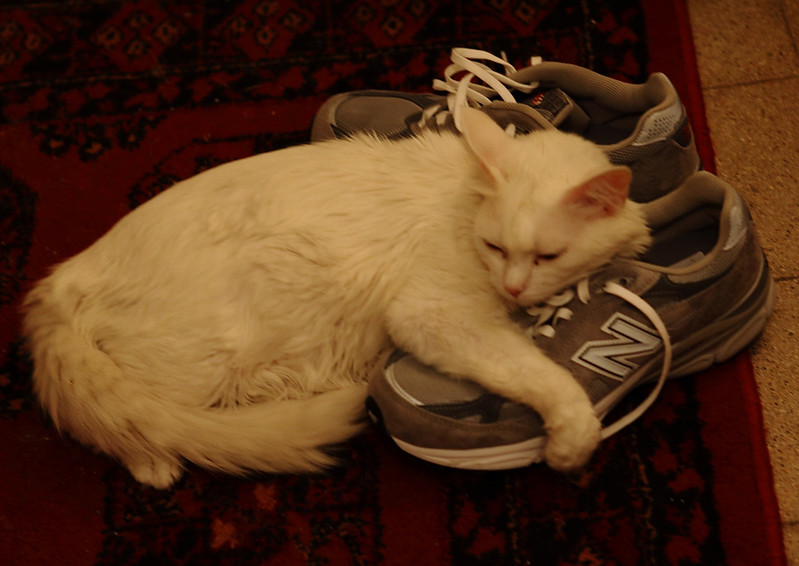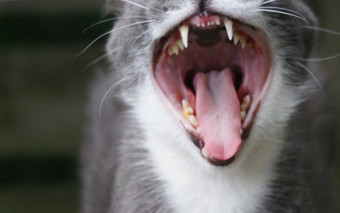
Cats have an excellent sense of smell, not quite on par with that of dogs, but certainly one that greatly exceeds the sniffing abilities of humans. Cats use scent in ways that humans do not – for example, by rubbing their scent glands (found for example on their cheeks, forehead, sides, and paws) on objects and other individuals to send messages (“I was here”) and create social bonds (“we are close”). I’ve also reported on studies that show that mom cats can recognize the scent of their kittens, and kittens also recognize the scent of their mom, even months later.
What about our scent? Do cats respond positively to it? Do they recognize us by our scent? It’s been suggested that leaving our cats with a familiar scented item (that smells of us) should provide them some comfort in our absence or when cats are otherwise stressed. A recent study, “The effect of owner presence and scent on stress resilience in cats,” provided a preliminary look at this question.
The research focused on the concept of the Secure Base Effect, which is the concept that being with someone you are bonded with can reduce stress and help you feel comfortable exploring unfamiliar environments. This theory was first developed in humans, and has since been validated in other species, as well as cross-species relationships. The current study looked at whether a human, or an object that smelled like them, would provide a “secure base” for a cat who has alone in a novel space.
To test this question, cat owners brought their cats to a laboratory space at Oregon State University. They also brough a “scented object” – something unwashed, that smelled like them, such as a shoe, sock, nightshirt, or blanket.

There were 42 cats in the study (16 males, 26 females) with an average age of six years. The study involved five phases:
- Baseline, where the owner sat on the floor in an area that had been marked with a 1-m radius circle, and the owner could interact with the cat whenever they entered the circle during a 2-minute period
- Alone Phase 1: The owner left the room for two minutes
- Return Phase 1: One of two things happened – either the owner returned to the room for two minutes to sit in the circle, or an unfamiliar researcher entered (wearing gloves) and placed the scented item in the circle
- Alone Phase 2: The owner either left the room, or the scented object was removed by the unfamiliar researcher, and the cat was alone for two minutes
- Return Phase 2: This return phase was the opposite of the first; if the owner had been present in Return Phase 1, then the scented item was brought in by the experimenter. If the scented item had been present in Return Phase 1, then the owner returned this time.
Half the cats were tested in the order Baseline-Alone-Human-Alone-Scent, and the other half in Baseline-Alone-Scent-Alone-Human. The researchers were interested in the number of distress vocalizations emitted by the cat, and time the cat spent in the circle during the alone and return phases. They also measured the amount of rubbing on the human or scented object.
Cats vocalized a lot when left alone, and also vocalized more with the scented object than when the human was present. They also rubbed more against their human than the scented object, and did not spend much time in the circle with the scented object. When their human returned, the cats spent more time in the circle with their human, and they showed more of a “secure base effect” when their human returned for Phase 1 rather than Phase 2. Finally, cats were more likely to interact with the owner when they were present in return phase 1 than return phase 2 (so: Baseline-Alone-Human-Alone-Scent).
From these results, the researchers concluded that (1) most cats were comforted by the presence of their owners being left alone in a strange place and that (2) the cats did not receive much comfort from the presence of the human-scented item. In fact, some cats even seemed to have increased stress responses during the two-minute period with the scented item, and rarely rubbed on it.
Why might this be? One possibility is that the scented object just did not decrease stress! However, before we completely rule out the potential of comfort from familiar scented items, it’s important to note that the scented item was also associated with the presence of an unfamiliar person (the researcher who brought the item in and then removed it from the room). The presence of a stranger would have mimicked the experience a cat might have when staying in a boarding facility or veterinary clinic, but it could be that the stranger’s presence was what caused the stress, not the scented item (the scented item just didn’t help). It could have even made the object aversive due to the association with the stranger (more information is needed on how the cats felt about the stranger!).
It’s also possible that two minutes with a scented item when stressed is just not long enough for the cats to feel comfortable interacting with it. Because the owner was able to interact with the cat when the cat was in the circle, it’s also not surprising that the cat would rub more on the human, especially if the human was allowed to extend a hand or pet the cat during their 2-minute return (this is not clear from the methods in the paper).
The cats in the Baseline-Alone-Scent-Alone-Human were also separated from their owners longer, but at the time of the scented item presentation, they would have only been alone for two minutes, and there were no differences between the two testing orders and the amount of meowing.
This study is a good start at exploring the effects of social scent on cats. In the future, it would be good to control for the “stranger effect” and perhaps also standardize the scented item to ensure a similar level of “stinkiness.” It would also be interesting to know if a cat would be more comforted by an item that smell liked them instead of their human.
However, from this research, we can conclude that overall, cats are comforted by their owner’s presence, but did not appear to get much reassurance from something that smells like their owner, at least during a brief stressful situation.
Reference
Behnke, A. C., Vitale, K. R., & Udell, M. A. (2021). The effect of owner presence and scent on stress resilience in cats. Applied Animal Behaviour Science, 105444.



*sigh*
Just gonna throw this out there: My current cat seems to enjoy napping in places where my butt or crotch is or has recently been.
So… that.